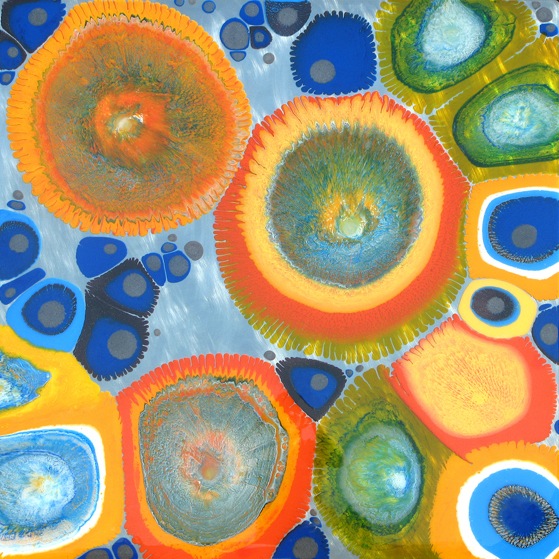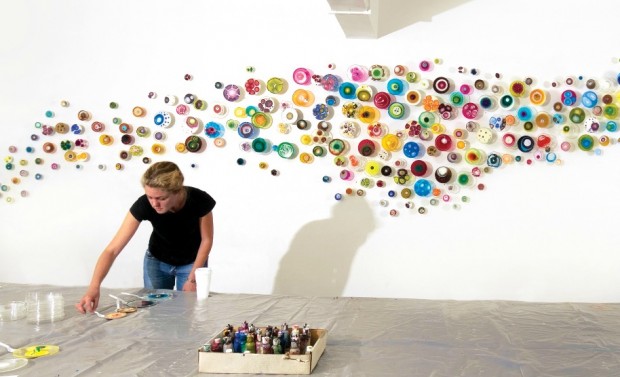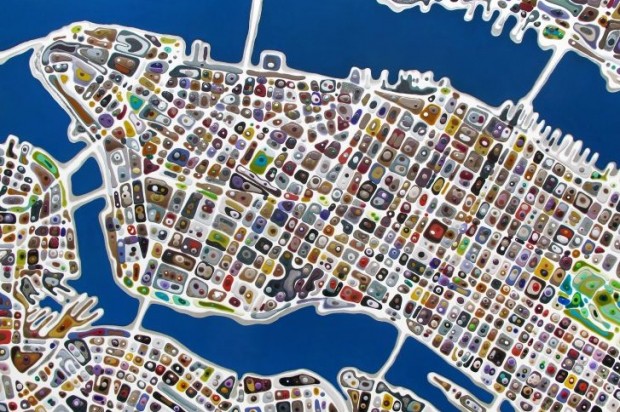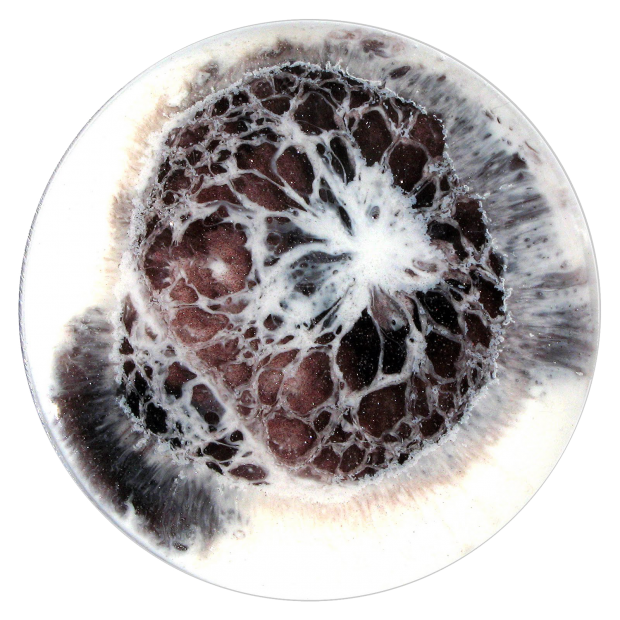An iconographic and text archive related to communication, technology and art.
☛ The Daily Dishes: A catalog of 365 Petri dishes painted by Klari Reis (all completed in 2010). Depicted above is “Untitled” from the Hypocondria series (read below for a detailed explanation). Click for hi-res (it’s worth it). © Klari Reis.
Klari Reis is an American artist born in 1977. She got her Master of Fine Arts (MFA) from the City and Guilds of London Art School in 2004 (CV: PDF). She has been working in San Francisco for the past six years.
Around the same time she got her degree from the London Art School, Klari Reis was diagnosed with Crohn’s Disease. She had to undergo a battery of tests. She eventually developed a strong interested in those results, especially in the ways her blood would react to different pharmaceuticals in Petri dishes. In fact, she liked it so much she decided to learn more about the whole process and found a way to study it at Kings College and at St. Thomas’ Hospital (both in London). She’s also actively working with biotech firms based in North Carolina for inspiration and is the owner her very own microscope (so she can do “small experiments” at home)1. At first, her art strongly reminded me of Erno-Erik Raitanen’s“Bacteriograms” (2008-2010). However, the techniques used in both cases are obviously quite different.
Klari Reis started painting colorful representations of pluricellular-like structures using epoxy polymer and mixed media on aluminum boards. She would name those pieces after pharmaceutical drugs (“Cefuroxime”, “Cloxacillin”, “Clindamaycin” for example). Here’s a description of those early pieces in a 2009 issue of Artweek magazine:
The basic motifs are circular blobs, often internally marked with smaller circles, a unit that evokes eyes when the interior is highly differentiated with various striations and flows. In other places, monochrome internal dots suggest breasts, and wavering outlines hint at amoebae. These motifs are spread across the surface, with different pieces gaining their individuality through the color schemes, and the relative density and ordering of the blobs. (Artweek: “Klari Reis and Carol Paxton Juliano at Cain Schulte Contemporary Art” by John Raptko, PDF; another description of Reis’s early work can be found at ArtRabbit)

The author of this description goes on noticing something that seems important in retrospective, almost prescient of what was about to come. It has to do with the aluminum board Reis was often using at that time:
(…) the frequently square supports gives the works a rhetoric suggestive of a sample or a specimen, a bit of something arbitrarily cut from an indeterminate large batch.
As it happened this work slowly evolved and, in 2009, Klari Reis started a new project where she would literally paint flat Petri dishes. This first series of Petri dishes was titled Hypocondriac2. The idea was not to produce figurative images, but rather to visually explore the endless variation of forms, colors and textures she had observed in the labs. She wasn’t always trying to make photorealistic reproductions of them:
“I occasionally try to make a Petri dish painting look exactly like an image I have been inspired by. However, I usually like to work just from memory and do my best to recall the natural formations seen and the way the shapes and reactions made me feel.” 1
She paints using an epoxy polymer which is basically a compound created from the reaction between a resin (or epoxide) and a hardener (or polyamine). She colors the polymer using various method and media (powders, oils, acrylics and industrial dyes for example). Since epoxy is highly toxic (see this fact sheet about “Epoxy Resin Systems” by the California Department of Public Health), she works in a controlled environment:
While conventional artists use a color palette and canvas to create art, Reis must clothe herself in a biohazard suit and oxygen mask. This is mandatory to protect her from the toxic fumes that result while combining various resins, epoxies and industrial dyes to create each one-of-a-kind piece. 3
Working on Hyponcondriac, Reis further developed and fine tuned her technique for painting Petri dishes. Eventually, her art evolved into a new project which she called Hypocondria (the ending “c” was dropped from the previous name). She now paints in real Petri dishes by filling them up with dyed epoxy polymer. Because this medium can also be used in a transparent or clear state, the result are paintings offering a striking sense of depth and volume: multiple level of colors are intertwined in a three dimensional volume4.


The mode of presentation evolved alongside Reis’s art. While the aluminum boards were hanged on the wall, the Petri dishes make use of a different hanging mechanism: they are “pinned” with steel rods at various distances from the wall, a little bit like butterflies on a white board. This method allows for the light to penetrate the Plexiglas from behind thus illuminating the translucent and glossy epoxy hardened in the dishes. Since hardened epoxy can sometime look like glass, the final result with the light coming through multiple Petri dishes of various colors arranged together could be compared to stained glass.


Each Petri dishes come in various size. The ones displayed on her blog The Daily Dish measure either 6, 4.5 or approximately 3 inches in diameter. None bear a specific title as they are all part of the myriad of dishes composing the ongoing Hypocondria series. For installations, Reis arrange multiple Petri dishes either in circular formations (for example she will arrange 30 pieces in a 28 inches wide circle) or amorphous shape. Given the nature of the Hypocondria series, installations can easily be adapted to various needs. For example, 1500 of her Petri dishes paintings ornate the walls of a hallway onboard the cruise ship Oasis of the Seas1.


Along with her ongoing Petri dishes series, Klari Reis keeps working on boards, creating new kaleidoskopic imagery. Her series Street Anatomy bring her interest for biological representation to a larger scale while she paints bird views of maps as if they were microbial universe.


To learn more about Klari Reis, here are some relevant links:
- Aside from The Daily Dish blog, Klari Reis has an official website (Flash is required). The site provide an overview of her art, form the flat aluminium boards to the Petri dishes. It also includes picture of other series such as Street Anatonomy and the Apothecary Bottle Project. Aside from pictures of her paintings, the website provide an artist statement, a short bio and a collection of relevant press releases. Reis also have a Facebook Page dedicated to her artistic activities.
- Klari Reis is currently represented by Cynthia Corbett Gallery. The gallery’s website offers the usual: a gallery of works, short biography, CV, current and past exhibition, press releases. A short PDF catalogue is also available for download (PDF).
- Anyone interested in this very peculiar kind of aesthetic should take a few minutes to visit the Microbial Art website.
- MycoRant: “The Petri Dish Art of Klari Reis” by January 10, 2011. That’s by far the most informative article about Klari Reis’s art I’ve been able to find online.
- Finally, below is a video of Klari Reis setting up a Petri dishes exhibition in Shangai, back in 2010. It’s an interesting document as it shows the process of fixing or pinning the Petri dishes on a dry wall.
• • •
1. MycoRant: “The Petri Dish Art of Klari Reis” April 15, 2010. ↩︎︎
2. On YouTube, one can see a video of an exposition of the series Hypocondriac at Art Hamptons during the summer of 2009: “Interview with Gallery Director Cynthia Corbett and artist Klari Reis at Art Hamptons 2009”.↩︎︎
3. The Denver Post: “An Oasis of art inspired by the “Natural World” by Bob Kelley, January 23, 2011. PDF.↩︎︎
4. Similar results are found in the art of Japanese artist Riusuke Fukahori. Fukahori also uses expoxy polymer to paint three dimensional gold fishes which appear to be frozen in a pond of transparent resine.↩︎︎
- By Philippe Theophanidis
- on
- ― Published in Art, Painting
- Tagged: biology, blood, body, Klari Reis, life, microbes, Petri dishes, pharmaceutical company

